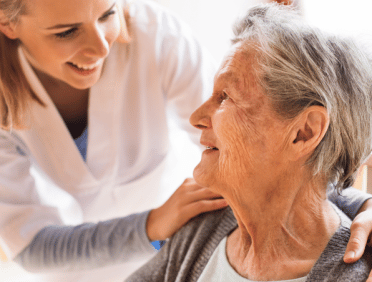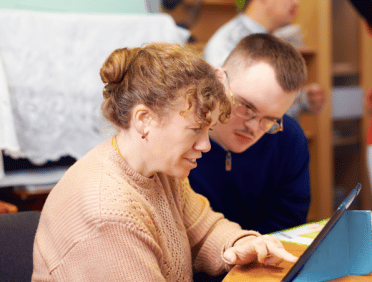Safeguarding Adults at Risk: Sexual Abuse
Sexual exploitation and abuse of vulnerable adults is an appalling violation of human rights and a serious criminal offense. It can have devastating and long-lasting effects on the physical, emotional, and psychological well-being of the victim. It is crucial that society takes strong measures to prevent, identify, and respond to sexual exploitation and abuse of vulnerable adults.
In this blog, we will discuss what sexual exploitation and abuse of vulnerable adults mean, how it is addressed by the Care Act 2014, and the different forms of sexual abuse that can occur. We will also explore how professionals can be trained to safeguard adults at risk.
What is sexual exploitation of vulnerable adults?
Sexual exploitation of vulnerable adults refers to any situation where an adult is coerced or manipulated into engaging in sexual activity or providing sexual favors in exchange for money, drugs, or other benefits. Vulnerable adults are individuals who are over the age of 18 but have a physical or mental disability, illness, or condition that makes them unable to protect themselves from harm or exploitation.
The perpetrators of sexual exploitation of vulnerable adults can be anyone, including relatives, caregivers, or strangers. They often use their position of power or trust to gain access to the victim and to coerce them into sexual activity. Sexual exploitation can also occur online through social media, dating apps, or other forms of digital communication.
The Care Act 2014 (safeguarding adults)
The Care Act 2014 is a piece of legislation that provides a legal framework for safeguarding adults at risk of harm or abuse. The Act requires local authorities to have a system in place for identifying adults who may be at risk of harm and to take appropriate steps to protect them.
The Act also places a duty on local authorities to carry out safeguarding enquiries when they receive information about an adult who may be at risk of harm or abuse. The enquiries must be conducted in a timely, proportionate, and person-centered manner, with the involvement of the adult at risk and their family and carers.
When investigating allegations of sexual abuse, the local authority must take steps to ensure that the victim is safe and protected from further harm. They must also gather evidence and information about the abuse, including any medical or forensic evidence, and ensure that the police are informed.
What is sexual abuse in vulnerable adults?
Sexual abuse in vulnerable adults refers to any non-consensual sexual activity or behavior that causes harm or distress to the victim. Sexual abuse can take many forms, including:
Inappropriate looking
Inappropriate looking refers to a form of non-contact sexual abuse where an individual, usually an adult, looks at or stares at a child in a sexual way. This type of behavior is often associated with voyeurism and can cause the child to feel uncomfortable, violated, and unsafe.
Inappropriate looking can be a precursor to more serious forms of sexual abuse, such as touching, fondling, or penetration. It is a violation of a child’s boundaries and can lead to long-term emotional and psychological harm.
It is important to understand that inappropriate looking is a form of sexual abuse and should be taken seriously. If you suspect that a child is being subjected to this kind of behavior, it is important to report it to the appropriate authorities, such as child protective services or law enforcement.
Inappropriate touching
Inappropriate touching covers any unwanted physical contact that is sexual in nature. This can include touching a child’s genitals, breasts, buttocks, or other intimate areas, as well as forcing the child to touch the abuser’s intimate areas.
Inappropriate touching is a form of physical sexual abuse and can cause significant harm to a child’s emotional and psychological well-being. It can lead to feelings of shame, guilt, and confusion, as well as long-term emotional and psychological effects, such as post-traumatic stress disorder (PTSD), depression, and anxiety.
It is important to recognise that inappropriate touching is a form of sexual abuse and should never be tolerated. If you suspect that a child is being subjected to this kind of behavior, it is important to report it to the appropriate authorities immediately, such as child protective services or law enforcement.
Indecent exposure
Indecent exposure refers to the act of exposing one’s genitals or other private body parts in a public place, with the intention of causing alarm or distress to others. In the context of sexual abuse, indecent exposure is a form of sexual misconduct that can cause significant emotional distress to its victims.
Exposure to indecent or sexual behavior can be particularly damaging to children, who may not fully understand the nature of the behavior or how to respond to it. It can lead to feelings of shame, guilt, and confusion, as well as long-term emotional and psychological effects, such as PTSD, depression, and anxiety.
It is important to recognise that indecent exposure is a form of sexual abuse and should never be tolerated. If you suspect that someone is engaging in this kind of behavior, it is important to report it to the appropriate authorities, such as law enforcement or child protective services, so that they can investigate and take appropriate action to protect the victims.
Rape
Rape is a form of sexual assault that involves any form of non-consensual sexual penetration, including vaginal, anal, or oral penetration. In the context of sexual abuse, rape is one of the most severe forms of sexual violence and can cause significant physical, emotional, and psychological trauma to its victims.
Rape is a violent act that involves the use of force or coercion to achieve sexual penetration without the victim’s consent. It is a serious criminal offense and should never be tolerated. Victims of rape may experience a wide range of emotional and psychological effects, such as PTSD, anxiety, depression, and suicidal thoughts.
It is important to recognise that rape is a form of sexual abuse and should be treated as a serious criminal offense. Victims of rape should be supported and provided with appropriate medical and psychological care. It is important to report incidents of rape to the appropriate authorities, such as law enforcement or sexual assault crisis centers, so that they can investigate and take appropriate action to ensure justice for the victim and prevent future occurrences.
Sexual acts to which the adult has not consented
Sexual acts to which the adult has not consented refers to any form of sexual activity that occurs without the consent of one or more adults involved. This can include non-consensual sexual touching, groping, kissing, or any other form of sexual activity that occurs without the explicit and voluntary consent of all parties involved.
In the context of sexual abuse, non-consensual sexual acts are a serious violation of an individual’s rights and can cause significant physical, emotional, and psychological harm. Victims of non-consensual sexual acts may experience a wide range of emotional and psychological effects, such as shame, guilt, trauma, anxiety, and depression.
It is important to recognise that non-consensual sexual acts are a form of sexual abuse and should be treated as a serious criminal offense. Victims of non-consensual sexual acts should be provided with appropriate medical and psychological care, as well as support from law enforcement and other authorities. It is important to report incidents of non-consensual sexual acts to the appropriate authorities, so that they can investigate and take appropriate action to ensure justice for the victim and prevent future occurrences.
Sexual assault
Sexual assault refers to any form of non-consensual sexual activity, including touching, groping, kissing, or any other sexual act that occurs without the explicit and voluntary consent of all parties involved. Sexual assault is a serious form of sexual violence and can cause significant physical, emotional, and psychological harm to its victims.
Sexual assault can take many forms, including rape, attempted rape, and other forms of non-consensual sexual penetration. Victims of sexual assault may experience a wide range of emotional and psychological effects, such as trauma, anxiety, depression, and post-traumatic stress disorder (PTSD).
It is important to recognise that sexual assault is a form of sexual abuse and should be treated as a serious criminal offense. Victims of sexual assault should be provided with appropriate medical and psychological care, as well as support from law enforcement and other authorities. It is important to report incidents of sexual assault to the appropriate authorities, so that they can investigate and take appropriate action to ensure justice for the victim and prevent future occurrences.
Sexual harassment
Sexual harassment refers to any form of unwanted sexual behavior, including unwanted sexual advances, requests for sexual favors, or other verbal or physical conduct of a sexual nature that is unwelcome or offensive. Sexual harassment is a form of discrimination and can create a hostile or intimidating environment for the victim.
Sexual harassment can take many forms, including unwanted touching, comments or gestures with sexual overtones, and sexual advances or propositions. Victims of sexual harassment may experience a wide range of emotional and psychological effects, such as fear, anxiety, depression, and low self-esteem.
It is important to recognise that sexual harassment is a form of sexual abuse and can be a violation of an individual’s rights. Victims of sexual harassment should be provided with support and resources to address their experience. It is important to report incidents of sexual harassment to the appropriate authorities, such as human resources, supervisors, or other individuals within an organisation, so that they can investigate and take appropriate action to prevent future occurrences.
Sexual photography
Sexual photography refers to the act of taking, possessing, or distributing sexually explicit images or videos of an individual without their consent. This is also known as non-consensual pornography or “revenge porn”. It is a form of sexual abuse that can cause significant emotional, psychological, and social harm to its victims.
Sexual photography often involves the use of technology such as smartphones, digital cameras, or social media platforms to take or distribute images without the victim’s knowledge or consent. Victims of sexual photography may experience a wide range of emotional and psychological effects, such as trauma, anxiety, depression, and feelings of violation and humiliation.
It is important to recognise that sexual photography is a form of sexual abuse and is illegal in many jurisdictions. Victims of sexual photography should be provided with support and resources to address their experience. It is important to report incidents of sexual photography to the appropriate authorities, such as law enforcement, so that they can investigate and take appropriate action to prevent the distribution of the images and hold the perpetrator accountable.
Sexual innuendo
Sexual innuendo refers to the use of words or gestures with sexual overtones that are intended to be suggestive or provocative. In the context of sexual abuse, sexual innuendo can create a hostile or intimidating environment for the victim, and can be a form of harassment or bullying.
Sexual innuendo can take many forms, including jokes, comments, or gestures that have sexual overtones or implications. Victims of sexual innuendo may experience a wide range of emotional and psychological effects, such as embarrassment, fear, anxiety, and low self-esteem.
It is important to recognise that sexual innuendo is a form of sexual abuse and can be a violation of an individual’s rights. Victims of sexual innuendo should be provided with support and resources to address their experience. It is important to report incidents of sexual innuendo to the appropriate authorities, such as human resources, supervisors, or other individuals within an organisation, so that they can investigate and take appropriate action to prevent future occurrences.
Sexual teasing
Sexual teasing refers to behavior that is sexually suggestive, flirtatious, or provocative. In the context of sexual abuse, sexual teasing can create a hostile or intimidating environment for the victim, and can be a form of harassment or bullying.
Sexual teasing can take many forms, including comments, gestures, or physical behavior that is intended to be sexually suggestive or provocative. Victims of sexual teasing may experience a wide range of emotional and psychological effects, such as embarrassment, fear, anxiety, and low self-esteem.
It is important to recognise that sexual teasing is a form of sexual abuse and can be a violation of an individual’s rights. Victims of sexual teasing should be provided with support and resources to address their experience. It is important to report incidents of sexual teasing to the appropriate authorities, such as human resources, supervisors, or other individuals within an organisation, so that they can investigate and take appropriate action to prevent future occurrences.
Subjection to pornography
Subjection to pornography refers to the exposure or distribution of pornographic material to an individual without their consent. This can include being forced to view or participate in pornography, or having explicit images or videos shared or distributed without their knowledge or consent. This is a form of sexual abuse and can cause significant emotional, psychological, and social harm to its victims.
Subjection to pornography can take many forms, including the use of technology to send, receive or view explicit images, videos, or other sexual content. Victims of subjection to pornography may experience a wide range of emotional and psychological effects, such as trauma, anxiety, depression, and feelings of violation and humiliation.
It is important to recognise that subjection to pornography is a form of sexual abuse and is illegal in many jurisdictions. Victims of subjection to pornography should be provided with support and resources to address their experience. It is important to report incidents of subjection to pornography to the appropriate authorities, such as law enforcement, so that they can investigate and take appropriate action to prevent the distribution of the images or videos and hold the perpetrator accountable.
Witnessing sexual acts
Witnessing sexual acts, in the context of sexual abuse, refers to being forced to watch or observe sexual activity without consent. This can include being made to watch pornography or witness sexual acts between other people. Witnessing sexual acts is a form of sexual abuse and can cause significant emotional, psychological, and social harm to its victims.
Witnessing sexual acts can take many forms, including being made to watch or observe sexual activity through the use of technology or in person. Victims of witnessing sexual acts may experience a wide range of emotional and psychological effects, such as trauma, anxiety, depression, and feelings of violation and humiliation.
It is important to recognise that witnessing sexual acts is a form of sexual abuse and is illegal in many jurisdictions. Victims of witnessing sexual acts should be provided with support and resources to address their experience. It is important to report incidents of witnessing sexual acts to the appropriate authorities, such as law enforcement or child protective services, so that they can investigate and take appropriate action to protect the victim and prevent future occurrences.
Safeguarding of Adults Training
Professionals who work with vulnerable adults, such as social workers, healthcare professionals, and support workers, must receive adequate training on how to safeguard adults at risk of sexual exploitation and abuse. Fortunately, there are many resources available to help professionals develop their skills and knowledge in this area.
One such resource is the Learn Q website, which offers a range of online training courses on safeguarding adults at risk. These courses cover topics such as recognising the signs and indicators of sexual exploitation and abuse, knowing how to respond to allegations of abuse, understanding the legal framework for safeguarding adults at risk, and supporting victims of abuse.
The training on Learn Q is tailored to the needs of the professional and is regularly updated to reflect any changes in legislation or policy. It also includes practical exercises and case studies to help professionals apply their knowledge in a practical setting.
In addition to online training, professionals can also attend face-to-face training sessions or workshops to further develop their skills and knowledge in safeguarding adults at risk. Local authorities and other organisations often provide such training opportunities, and professionals are encouraged to seek out and attend such events to enhance their skills and knowledge.
In conclusion, sexual exploitation and abuse of vulnerable adults is a serious criminal offense that can have devastating and long-lasting effects on the victim. It is crucial that society takes strong measures to prevent, identify, and respond to sexual exploitation and abuse of vulnerable adults. The Care Act 2014 provides a legal framework for safeguarding adults at risk, and professionals who work with vulnerable adults must receive training on how to safeguard them from sexual exploitation and abuse. By working together and taking a proactive approach, we can create a society where vulnerable adults are protected from harm and can live their lives free from fear and abuse.
- Learn Q’s Safeguarding Adults Level 1 is an introductory course that provides a basic understanding of safeguarding vulnerable adults. It covers the concept of safeguarding, the importance of safeguarding, the legislation in place to protect vulnerable adults, the signs of abuse and how to avoid them, and how to respond when a vulnerable adult discloses they are being abused or neglected. This course is suitable for anyone who works with vulnerable adults, including managers, supervisors, employees, and volunteers at all levels.
- Learn Q’s Safeguarding Adults Level 2 course, on the other hand, is a more advanced course that builds on the knowledge gained in Level 1. It provides a more in-depth understanding of safeguarding, including recognising abuse, the responsibilities of different safeguarding roles, effective communication, and how to handle concerns and incidents related to safeguarding. This course is designed for those with additional safeguarding responsibilities, such as those who work in hospitals, general practices, nursing homes, care homes, or domiciliary care, as well as in religious organisations and community organisations.
Overall, while both courses cover the essential knowledge and skills needed to safeguard vulnerable adults, Safeguarding Adults Level 2 provides a more comprehensive and detailed understanding of safeguarding, which is important for those who have additional safeguarding responsibilities.
These courses are ideal for those who work in hospitals, general practices, nursing homes, care homes, domiciliary care, as well as in religious and community organisations. By completing this course, you will be better equipped to handle safeguarding concerns and to ensure the safety and well-being of vulnerable adults.
At Learn Q, we are committed to providing high-quality training that meets the needs of professionals across a range of industries. Our Safeguarding Adults courses are designed to provide you with the knowledge and skills you need to excel in your role and make a real difference in the lives of vulnerable adults. Sign up today and take the next step in your career!
Conclusion
Psychological abuse is a serious issue that can have devastating effects on individuals. It is important to recognise the common examples of psychological abuse, provide appropriate training to staff, and have policies and procedures in place to prevent and respond to this form of abuse.
By working together, health and social care providers can ensure that adults at risk are protected and supported, and that their needs and preferences are at the center of all decision-making.
To download a .pdf of this blog, please click here












